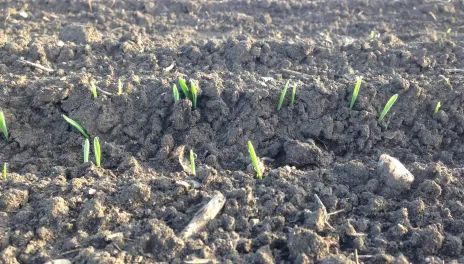Expectantly waiting
You’ve probably seen the meme with eleven (more?) seasons in North Dakota. Along with the Four Seasons: spring, summer, autumn, and winter, some evil genius has added fool’s spring, followed by second winter, several other false starts at spring, and then ‘actual spring.’ You can imagine how the rest of the freshly-coined seasons run. Frankly, my sincere hope is that spring falls on a weekend this year.
All kidding about numerous short seasons aside, we’re all waiting for real spring. Planting season. As we wait, though, we prepare. Everywhere I look, our CREC teams are preparing.
Our lab receives seed all year long, but when the first seed arrives in January, that signals the start, for me. Our lab staff log, count and weigh seed and test germination. They meticulously pack seed into tiny coin envelopes, identify them with bar codes and arrange them in custom-built trays, ready for their turn in our planters. Some seed spends only a day or two here, as it’s quickly repackaged and bar-coded for shipment to another NDSU REC for a replicated or variety trial.
On a much larger scale, our Foundation Seedstocks staff dispense thousand-pound totes and even full truckloads of seed to farmers, and allocate smaller portions for research projects across the United States.
Our technicians have been working all winter long, taking care of routine maintenance on tractors, plot combines and planters, and some fleet vehicles. They’ve been helping with building maintenance, inside and out. Some of our crew move snow with payloaders and skid steers, but a small group keep sidewalks clear with small snowblowers and shovels. Along with the routine and expected repairs to equipment and buildings, they also show a creative side, thinking ahead to adopt new technologies and improve how we conduct research.
Our pathology team has been growing pathogens, developing protocols, laying in new stocks of irrigation line and sprinkler heads, and reconditioning used equipment to prepare for a labor-intensive summer filled with treatment applications and misting system adjustments.
Our orchard manager has been surveying winter and wind damage and pruning fruit trees and shrubs.
Our livestock team has been welcoming new calves to our herd, finishing out a winter feedlot project, monitoring a capital building project, and waiting for bids on another building project.
Our scientists and specialists continue their year-round efforts toward grant writing and putting the final touches on new protocols, on-station and off-station. The search for grad students, interns, and summer crew is ongoing. We have several active searches underway, and some of our professional staff are serving on current search committees.
Our Extension team experienced a normal, active schedule this winter, extending university research at professional conferences and local workshops. Planning never stops, though, as the next meeting are always on the horizon. Have you marked Field Days on your calendar?
Support staff fill in many gaps, keeping the paperwork and electronic files flowing, shipments moving in and out, scheduling and meeting deadlines, and greeting individuals and helping with or at large meetings from registration to pack out.
It seems we do a lot of hurrying and then waiting and then wishing we had a little of the waiting time back again. I suppose it’s not unlike most farming and ranching operations. It’s good work, and we’re happy to do it. We wish you a safe and prosperous growing season.
Linda Schuster
Linda.Schuster@ndsu.edu
Administrative Assistant
